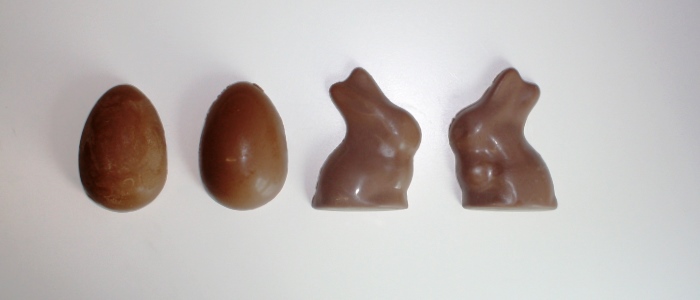News
3D printing bone tissue
Jun 28 2022
At ACES we will use any eggs-cuse to hook into Easter goodies before the Christian feast – but hey, we’re trying to eggs-plain a little science, OK?

Before you crack into your Easter treats this year, pause for a moment to look at your hands – they share something with the bunnies above.
Your hands and the bunnies are said to be “chiral”, (derived from the ancient Greek word for hand). They are mirror images of each other, but no matter which way you rotate them they cannot be laid on top of each other to match up – they are non-superimposable mirror images of each other. (The eggs above are termed ‘achiral’ – their mirror images are superimposable.) What’s this got to do with chocolate?
Chirality is a property seen at the molecular level and throughout nature. One of the sugars used in chocolate manufacture – glucose, is also chiral. Both types of glucose have identical taste but the ‘left-hand’ type (the naturally occurring one) our stomachs can process, while the other, they can’t.
Good egg / bad egg
Eggheads may have joined the dots – since our bodies can’t absorb this type of glucose, why can’t we substitute this sugar for the other and then we can eat many more trains of eggs, right? Choo-choo, roll out the eggs-periment!
Turns out it works. Sweet, you say. Well, no, in this case it’s a bad egg – laxative! This form of the sugar is the same in every respect – same molecular formula (six carbons, 12 hydrogens and 6 oxygens), same density, same solubility in water, etc, but its different shape, i.e., its chirality or ‘handedness’, causes eggs-plosive results.
In fact, this sugar has been proposed as a possible colonoscopy preparation!
Mint or cumin?
Like those little spearmint eggs? Oil of spearmint may have been used to produce the taste and guess what – the molecule in the oil that tastes like mint, carvone, is also chiral. If chocolatiers were to use the other form, those little minty goodies would taste like the spice cumin. So it’s not just our stomachs that may notice chiral molecules, our noses and tastebuds might too.
Helical chirality and ANFF’s eggs
The illustration below by Australian National Fabrication Facility’s Chris Richards demonstrates the nature of helical chirality. Notice how one egg has a clockwise spiral, while the other has an anticlockwise spiral.
ACES researchers will take an Easter break from turning their hands to making muscles by exploiting the handedness of helical chirality.
Long-time ACES collaborator Professor Ray Baughman of University of Texas at Dallas illustrated the point.
“To make these strong muscles they insert twist in ordinary fishing line or sewing thread, and then coil them,” he said.
“If the handedness of twist is the same as that of coiling, the muscles contract when heated, generating mechanical power during contraction that can be five times higher on a per weight basis than generated by your car’s gasoline engine.
“If the handedness of twist and coiling differ, then the artificial muscles expand when heated.”
ACES and chirality have a long history, with the late Professor Leon Kane-Maguire long ago making chiral polymers that conduct like metals. (In fact, Leon himself was a mirror (chiral) twin!)
Enough shoptalk, time to get our ‘chirals’ on as many choccies as possible.
Kalo Pascha (Greek for Happy Easter)













